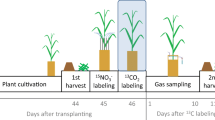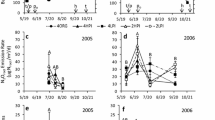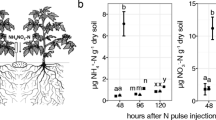Abstract
In annual crops, the partitioning of photosynthates to support root growth, respiration and rhizodeposition should be greater during early development than in later reproductive stages due to source/sink relationships in the plant. Therefore, seasonal fluctuations in carbon dioxide (CO2) and nitrous oxide (N2O) production from roots and root-associated soil may be related to resource partitioning by the crop. Greenhouse studies used 13C and 15N stable isotopes to evaluate the carbon (C) partitioning and nitrogen (N) uptake by corn and soybean. We also measured the CO2 and N2O production from planted pots as affected by crop phenology and N fertilization. Specific root-derived respiration was related to the 13C allocated to roots and was greatest during early vegetative growth. Root-derived respiration and rhizodeposition were greater for corn than soybean. The 15N uptake by corn increased between vegetative growth, tasseling and milk stages, but the 15N content in soybean was not affected by phenology. A peak in N2O production was observed with corn at the milk stage, suggesting that the corn rhizosphere supported microbial communities that produced N2O. Most of the 15N-NO3 applied to soybean was not taken up by the plant and negative N2O production during vegetative growth and floral initiation stages suggests that soybean roots supported the reduction of N2O to dinitrogen (N2). We conclude that crop phenology and soil N availability exert important controls on rhizosphere processes, leading to temporal variation in CO2 and N2O production.



Similar content being viewed by others
Abbreviations
- ANOVA:
-
analysis of variance
- DAS:
-
days after seeding
- HSD:
-
honestly significantly different
References
Bromand S, Whalen JK, Janzen HH, Schjoerring JK, Ellert BH (2001) A pulse-labelling method to generate 13C-enriched plant materials. Plant Soil 235:253–257. doi:10.1023/A:1011922103323
Buyanovsky GA, Wagner GH (1997) Crop residue input to soil organic matter on Sanborn Field. In: Paul EA, Paustian K, Elliott ET, Cole CV (eds) Soil organic matter in temperate agroecosystems: long-term experiments in North America. CRC, Boca Raton, FL, pp 73–83
Cheng W, Johnson DW, Fu S (2003) Rhizosphere effect on decomposition: Controls of plant species, phenology, and fertilization. Soil Soc Am J 67:1418–1427
Cheng W (2008) Rhizosphere priming effect: its functional relationships with microbial turnover, evapotranspiration, and C-N budgets. Soil Biol Biochem. doi:10.1016/j.soilbio.2008.04.018
Coyne MS, Focht DD (1987) Nitrous oxide reduction in nodules: denitrification or N2 fixation. Appl Environ Microbiol 53:1168–1170
Ding W, Cai Y, Cai Z, Yagi K, Zheng X (2007) Soil respiration under maize crops: effects of water, temperature, and nitrogen fertilization. Soil Sci Soc Am J 71:944–951
Drury CF, Yang XM, Reynolds WD, McLaughlin NB (2008) Nitrous oxide and carbon dioxide emissions from monoculture and rotational cropping of corn, soybean and winter wheat. Can J Soil Sci 88:163–174
Fehr WR, Caviness CE, Burmood DT, Pennington JS (1971) Stages of development descriptions for soybeans, Glycine max. (L.). Merr. Crop Sci 11:929–930
Freney JR (1997) Emission of nitrous oxide from soils used for agriculture. Nutr Cycl Agroecosyst 49:1–6. doi:10.1023/A:1009702832489
Fu S, Cheng W, Susfalk R (2002) Rhizosphere respiration varies with plant species and phenology: A greenhouse pot experiment. Plant Soil 239:133–140. doi:10.1023/A:1014959701396
Gavrichkova O, Kuzyakov Y (2008) Ammonium versus nitrate nutrition of Zea mays and Lupinus albus: Effect on root-derived CO2 efflux. Soil Biol Biochem . doi:10.1016/j.soilbio.2008.08.003
Guenzi WD, Beard WE, Watanabe FS, Olsen SR, Porter LK (1978) Nitrification and denitrification in cattle manure-amended soil. J Environ Qual 7:196–202
Hanson PJ, Edwards NT, Garten CT, Andrews JA (2000) Separating root and soil microbial contributions to soil respiration: A review of methods and observations. Biogeochem 48:115–146. doi:10.1023/A:1006244819642
Hoch GE, Schneider KC, Burris RH (1960) Hydrogen evolution and exchange, and conversion of N2O to N2 by soybean root nodules. Biochim Biophys Acta 37:273–279. doi:10.1016/0006-3002(60)90234-1
Holland EA, Robertson GP, Greenberg J, Grossman PM, Boone RD, Gosz JR (1999) Soil CO2, N2O and CH4 exchange. In: Robertson GO, Coleman DC, Bledsoe CS, Sollins P (eds) Standard soil methods for long-term ecological research. Oxford University, NY, pp 185–201
Hütsch BW, Augustin J, Merbach W (2002) Plant rhizodeposition–an important source for carbon turnover in soils. J Plant Nutr Soil Sci 165:397–407. doi:10.1002/1522-2624(200208)165:4<397::AID-JPLN397>3.0.CO;2-C
Johnson JM-F, Allmaras RR, Reicosky DC (2006) Estimating source carbon from crop residues, roots and rhizodeposits using the national grain-yield database. Agron J 98:622–636. doi:10.2134/agronj2005.0179
Keith H, Oades JM, Martin JK (1986) Input of carbon to soil from wheat plants. Soil Biol Biochem 18:445–449. doi:10.1016/0038-0717(86)90051-9
Killham K, Yeomans L (2001) Rhizosphere carbon flow measurement and implications: from isotopes to reporter genes. Plant Soil 232:1573–5036. doi:10.1023/A:1010386019912
Kuzyakov Y, Cheng W (2004) Photosynthesis controls of CO2 efflux from maize rhizosphere. Plant Soil 263:85–99. doi:10.1023/B:PLSO.0000047728.61591.fd
Kuzyakov Y, Domanski G (2000) Carbon input by plants into soil. J Plant Nutr Soil Sci 163:421–431. review. doi:10.1002/1522-2624(200008)163:4<421::AID-JPLN421>3.0.CO;2-R
Kuzyakov Y, Siniakina SV (2001) A novel method for separating root-derived organic compounds from root respiration in non-sterilized soil. J Plant Nutr Soil Sci 164:511–517. doi:10.1002/1522-2624(200110)164:5<511::AID-JPLN511>3.0.CO;2-T
Lal R (2008) Carbon sequestration. Philos Trans R Soc B 363:815–830. doi:10.1098/rstb.2007.2185
Littell RC, Milliken GA, Stroup WW, Wolfinger RD (2006) SAS for mixed models. SAS Institute Inc., Cary, NC, p 814
Liu XJ, Mosier AR, Halvorson AD, Reule CA, Zhang FS (2007) Dinitrogen and N2O emissions in arable soils: effects of tillage, N source and soil moisture. Soil Biol Biochem 39:2362–2370. doi:10.1016/j.soilbio.2007.04.008
Lyons JC, Earley EB (1952) The effect of ammonium nitrate applications to field soils on nodulation, seed yield and nitrogen and oil content of the seed of soybeans. Soil Sci Soc Am Proc 16:259–263
Martens R (1990) Contribution of rhizodeposits to the maintenance and growth of soil microbial biomass. Soil Biol Biochem 22:141–147. doi:10.1016/0038-0717(90)90078-E
O’Hara GW, Daniel RM (1985) Rhizobial denitrification: a review. Soil Biol Biochem 17:1–9. doi:10.1016/0038-0717(85)90082-3
Pausch RC, Mulchi CL, Lee EH, Forseth IN, Slaughter LH (1996) Use of 13C and 15N isotopes to investigate O3 effects on C and N metabolism in soybeans. 1. C fixation and translocation. Agric Ecosyst Environ 59:69–80. doi:10.1016/0167-8809(96)01042-0
Qian JH, Doran JW, Walters DT (1997) Maize plant contributions to root zone available carbon and microbial transformations of nitrogen. Soil Biol Biochem 29:1451–1462. doi:10.1016/S0038-0717(97)00043-6
Ritchie SW, Hanway JJ, Benson GO (1986) How a corn plant develops. Iowa State Univ. Coop. Ext. Serv. Spec. Rep. 48
Reicosky DC, Lindstrom MJ (1993) Fall tillage method: Effect on short-term carbon dioxide flux from soil. Agron J 85:1237–1243
Rochette P, Angers DA, Belanger G, Chantigny MH, Prevost D, Levesque G (2004) Emissions of N2O from alfalfa and soybean crops in eastern Canada. Soil Sci Soc Am J 68:493–506
Rochette P, Angers DA, Côté D (2000) Soil carbon and nitrogen dynamics following application of pig slurry for the 19th consecutive year: I- Microbial biomass carbon and CO2 fluxes. Soil Sci Soc Am J 64:1389–1395
Rochette P, Bertrand N (2007) Soil-surface gas emissions. In: Carter MR, Gregorich EG (eds) Soil sampling and methods of analysis. CRC, Boca Raton, FL, pp 851–861
Rochette P, Flanagan LB (1997) Quantifying rhizosphere respiration in a corn crop under field conditions. Soil Sci Soc Am J 61:466–474
Rochette P, Flanagan LB, Gregorich EG (1999) Fractionation of total soil respiration into root-rhizosphere and soil components. Soil Sci Soc Am J 63:1207–1213
Rochette P, Gregorich EG (1998) Dynamics of soil microbial biomass C, soluble organic C and CO2 evolution after three years of manure application. Can J Soil Sci 78:283–290
Rochette P, Janzen HH (2005) Towards a revised coefficient for estimating N2O from legumes. Nutr Cycl Agroecosyst 73:171–179. doi:10.1007/s10705-005-0357-9
Sadler EJ, Karlen DL (1995) Aerial dry matter and nutrient accumulation comparison among five soybean experiments. Commun Soil Sci Plant Anal 26:3145–3163. doi:10.1080/00103629509369516
Sey BK, Whalen JK, Gregorich EG, Rochette P, Cue RI (2008) Carbon dioxide and nitrous oxide content in soils under corn and soybean. Soil Sci Soc Am J 72:931–938. doi:10.2136/sssaj2007.0093
Singh A (2004) Effect of fertilization on N and P resorption efficiency of selected leguminous and non-leguminous trees planted in a coal mine spoil. J Indian Inst Sci 84:174–182
Smith BN, Epstein S (1971) Two categories of 13C/12C ratios for higher plants. Plant Physiol 47:380–384. doi:10.1104/pp. 47.3.380
Subke J-A, Inglima I, Cotrufo F (2006) Trends and methodological impacts in soil CO2 efflux partitioning: a metaanalytical review. Glob Change Biol 12:921–943. doi:10.1111/j.1365-2486.2006.01117.x
Swinnen J, VanVeen JA, Merckx R (1994) 14C pulse-labeling of field-grown spring wheat: an evaluation of its use in rhizosphere carbon budget estimations. Soil Biol Biochem 26:161–170. doi:10.1016/0038-0717(94)90159-7
Voisin AS, Salon C, Jeudy C, Warembourg FR (2003) Seasonal patterns of 13C partitioning between shoots and nodulated roots of N2 or nitrate-fed Pisum sativum L. Ann Bot (Lond) 91:539–546. doi:10.1093/aob/mcg055
Warembourg FR, Estelrich HD (2001) Plant phenology and soil fertility effects on below-ground carbon allocation for an annual (Bromus madritensis) and a perennial (Bromus erectus) grass species. Soil Biol Biochem 33:1291–1303. doi:10.1016/S0038-0717(01)00033-5
Werth M, Kuzyakov Y (2005) Below-ground partitioning (14C) and isotopic fractionation (δ13C) of carbon recently assimilated by maize. Isotopes Environ Health Stud 41:237–248. doi:10.1080/10256010500230163
Wilts AR, Reicosky DC, Allmaras RR, Clapp CE (2004) Long-term corn residue effects: harvest alternatives, soil carbon turnover, and root-derived carbon. Soil Sci Soc Am J 68:1342–1351
Yang LF, Cai ZC (2006) Soil respiration during a soybean-growing season. Pedosphere 16:192–200. doi:10.1016/S1002-0160(06)60043-X
Acknowledgements
Funding for this project came from the Biological Greenhouse Gases Sources and Sinks Program of the Canadian Agri-Food Research Council.
Author information
Authors and Affiliations
Corresponding author
Additional information
Responsible Editor: Elizabeth Baggs.
Rights and permissions
About this article
Cite this article
Sey, B.K., Manceur, A.M., Whalen, J.K. et al. Root-derived respiration and nitrous oxide production as affected by crop phenology and nitrogen fertilization. Plant Soil 326, 369–379 (2010). https://doi.org/10.1007/s11104-009-0018-x
Received:
Accepted:
Published:
Issue Date:
DOI: https://doi.org/10.1007/s11104-009-0018-x




